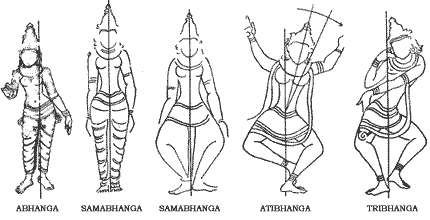A 2006 essay "Tribhanga: Strike A Pose" by Anil Menon discusses a lovely classical Indian stance that looks like a déhanchement posture. Menon's musings begin with an image from an old sculpture:
She rocks, this woman in the stone. It is difficult to believe that she is about a thousand years old. We don't know much about her. She may represent a dancer, devadasi, apsara, maid or courtesan. She adorns the Adinatha temple in the eastern group of temples in Khajuraho, Madhya Pradesh. During the tenth and eleventh centuries, when Europe was a God-haunted place turned by the bubonic plague into a vast graveyard, the Chandela Rajputs embarked on a joyous architectural project of unequalled moral courage and aesthetic ambition. The woman in the stone was one of their minor discoveries.
Unlike the other adornments in the temples, she is turned away from the viewer's eye; the characteristic "glancing away" look used in Indian art (and by teenagers) to signal a pretended unawareness has been turned into an actual unawareness; the viewer becomes a voyeur, if only for that moment of turning away. The centuries are now like a lens through which we happen to see a very beautiful woman caught turning in mid-dance. Dancing is what she must be doing, for it is too stylized to be anything else.
The pose in which her sculptor — some unknown genius — found her is called the tribhanga, which means, roughly, "equipoised stance bent in three places." In the western aesthetic tradition, the tribhanga is known as the "contrapposto." The tribhanga is one of the five bhangas (equipoised stances) in traditional Indian dance: the others are shown in the figure on the right. The abhanga and tribhanga poses were both very popular in ancient and medieval Indian art. ...
He goes on to discuss other aspects of tribhanga, and ends with:
Francis Bacon write in his essay On Beauty that "there is no excellent beauty that hath not some strangeness in proportion." In our age we're once again slowly discovering that the converse is true as well: there is no proportion that is not in some way strangely beautiful. The unsettling ability to see beauty in the conventional as well as in the blasphemous is perhaps the true legacy of the people who carved into life that woman in stone.
^z - 2017-10-13
